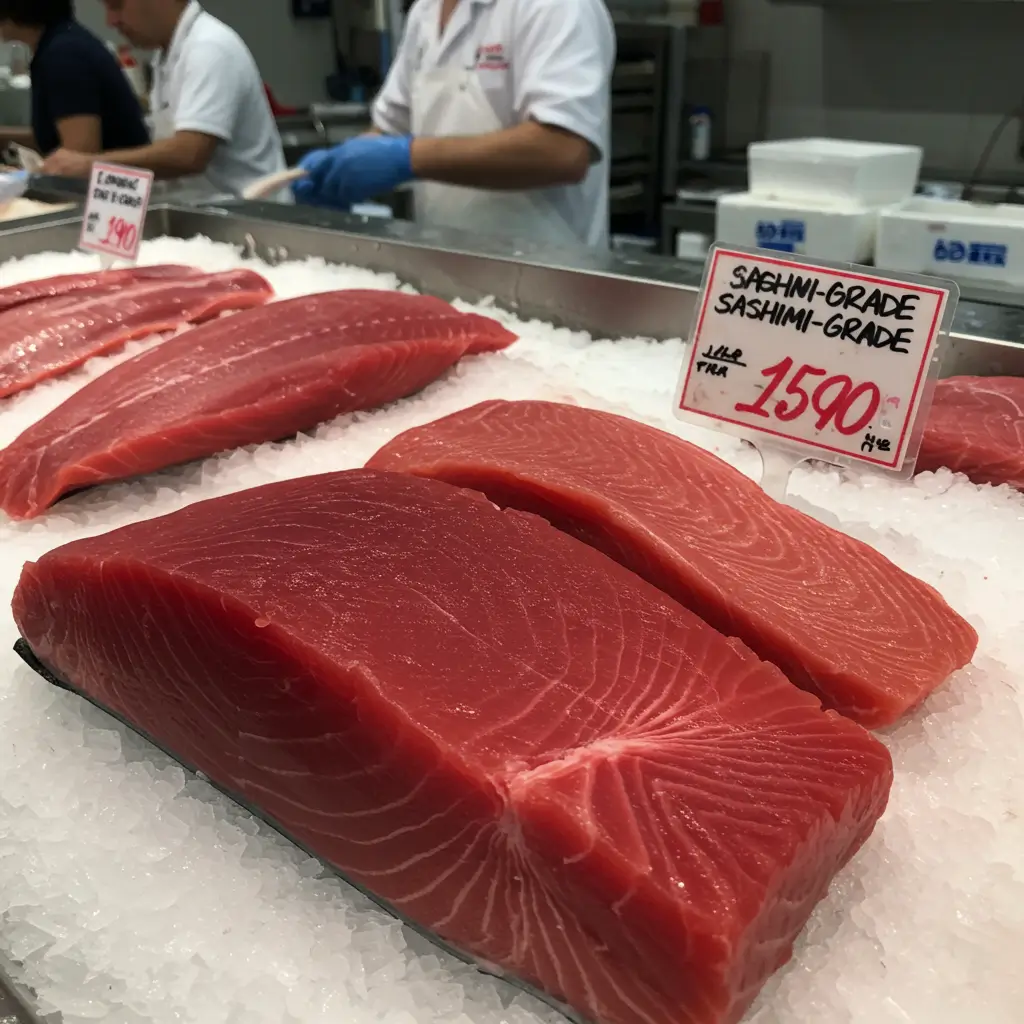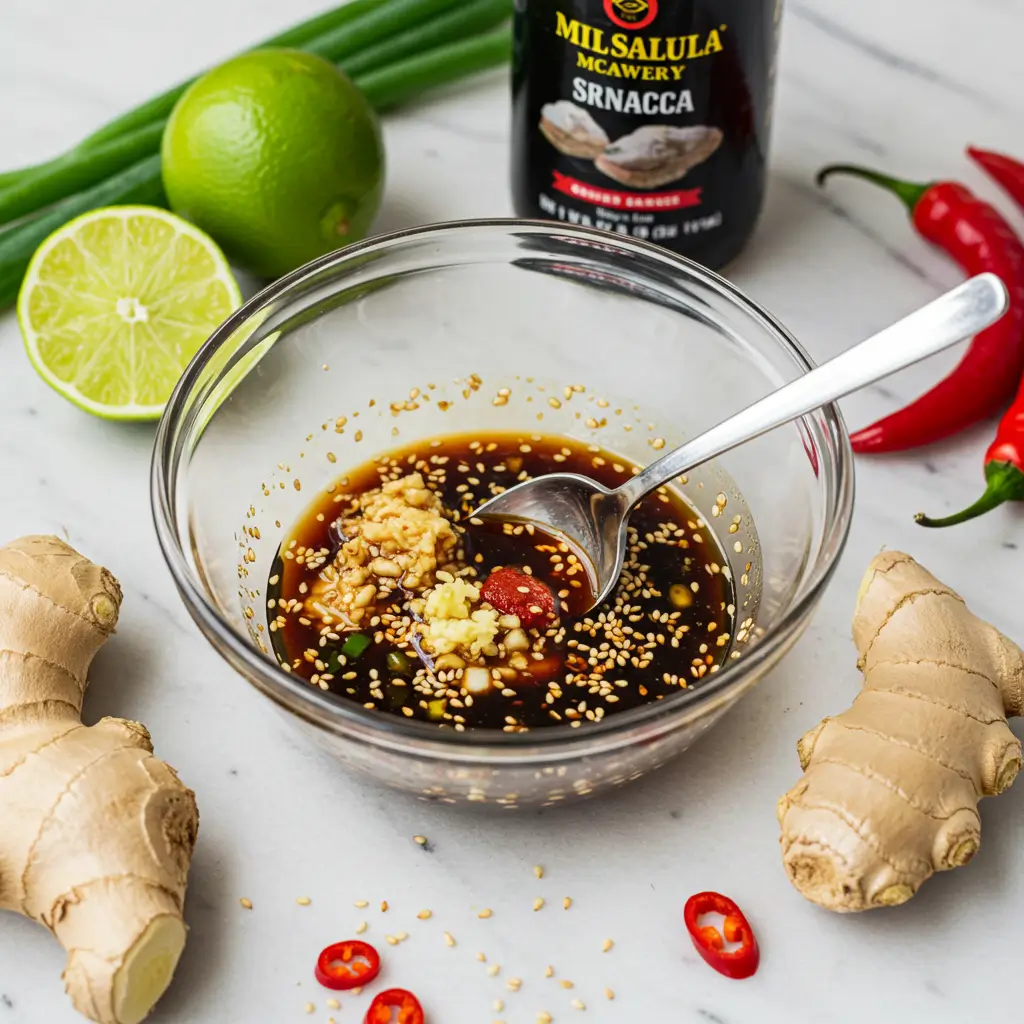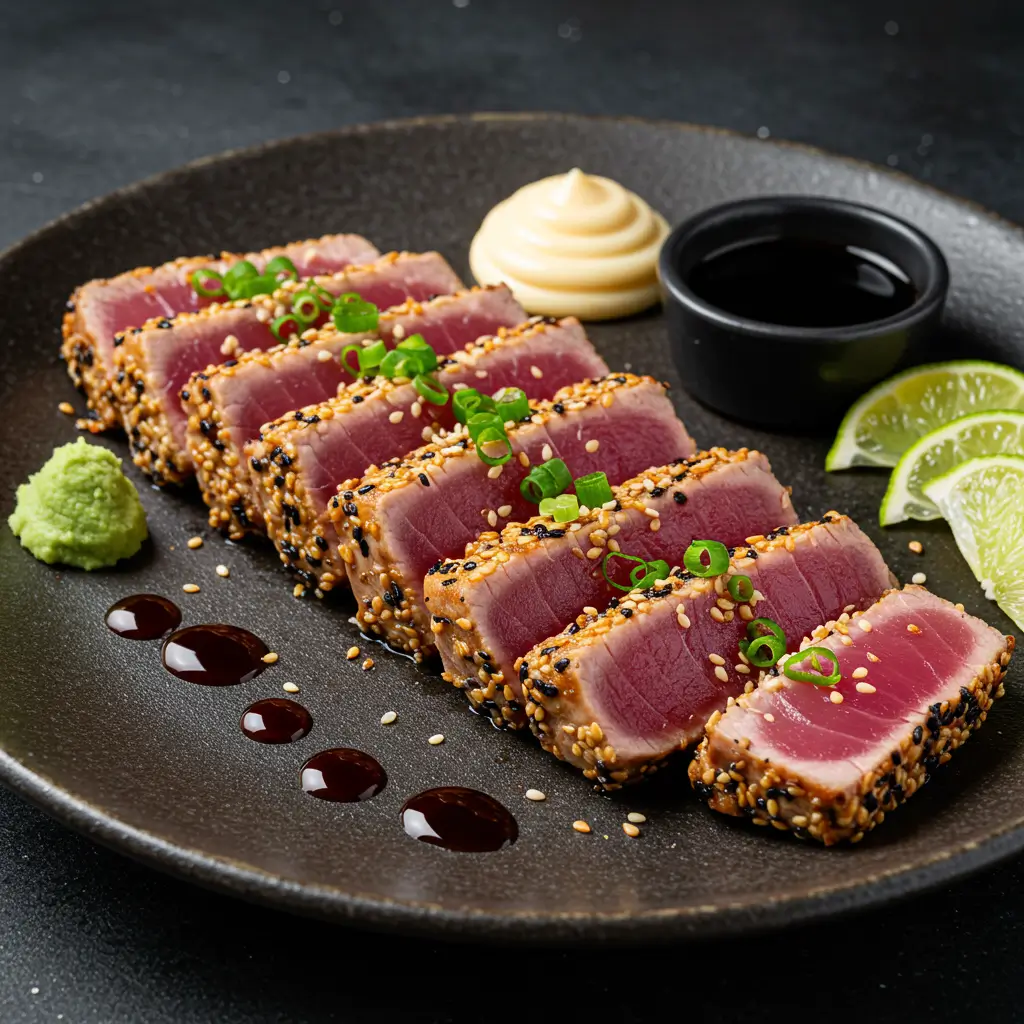If you’re a seafood lover, there’s nothing quite like a perfectly cooked ahi tuna steak—tender on the inside, slightly crispy on the outside, and bursting with flavor. This high-quality fish, often found on gourmet restaurant menus, is not only delicious but also incredibly healthy, packed with lean protein, omega-3 fatty acids, and essential nutrients.
One of the best things about ahi tuna is its quick cooking time—you can have a restaurant-worthy dish on your plate in just 10 minutes! Whether you enjoy it seared, grilled, or raw in poke bowls and sushi, its versatility makes it a must-try for home cooks.
In this guide, you’ll learn how to make the perfect seared ahi tuna steak like a pro chef. From selecting the freshest sashimi-grade tuna to mastering the perfect sear, I’ll walk you through step-by-step instructions, essential ingredients, and pro tips to ensure your ahi tuna is flavorful, tender, and absolutely delicious. Let’s get started! 🚀🔥
What Is Ahi Tuna and Why Choose Sashimi-Grade?
Ahi Tuna vs. Regular Tuna: What’s the Difference?
Tuna is a popular seafood choice, but not all tuna varieties are the same. Ahi tuna, also known as yellowfin tuna, differs significantly from regular tuna in texture, flavor, and best cooking methods. Understanding these differences helps you choose the right type of tuna for your dish.
Ahi Tuna: A Premium, Delicate Choice
Ahi tuna, or yellowfin tuna, is prized for its mild flavor and firm yet tender texture. This variety has a light pink to deep red flesh, depending on freshness and diet. Because of its leaner composition, it has a clean, slightly sweet taste, making it ideal for sashimi, sushi, and seared preparations.
Unlike regular canned tuna, ahi tuna steaks cook quickly and should be served medium-rare or rare to preserve moisture and flavor. Overcooking can make the meat dry and chewy. Restaurants often use ahi tuna for gourmet dishes due to its buttery texture and high quality.
Regular Tuna: Versatile but Less Refined
“Regular tuna” typically refers to albacore or skipjack tuna, the most common varieties found in cans and pre-packaged meals. These types have lighter-colored flesh, ranging from pale pink to off-white, and a firmer, flakier texture compared to ahi tuna.
Albacore tuna has a mild flavor, making it a versatile choice for salads, sandwiches, and casseroles. Skipjack tuna, often labeled as “light tuna”, has a stronger, more pronounced taste due to its higher fat content. Both varieties work well in cooked and preserved preparations, but they lack the delicate texture that makes ahi tuna perfect for searing.
Which One Should You Choose?
The best choice depends on how you plan to prepare the tuna. If you want a high-end, restaurant-quality dish, ahi tuna is the best option. Its tenderness and rich taste shine when lightly seared or served raw. However, for cooked dishes, meal prepping, or budget-friendly meals, regular tuna (especially albacore) works well.
Understanding these differences allows you to select the best tuna for your recipe. If you’re aiming for a gourmet seafood experience, ahi tuna is the clear winner.
Why Sashimi-Grade Tuna Matters for Freshness and Safety
Not all tuna is safe to eat raw. If you plan to make seared ahi tuna, sushi, or poke, always choose sashimi-grade tuna. This label ensures that the fish meets strict handling and freezing standards to reduce the risk of parasites and contamination.
Sashimi-Grade Tuna Ensures Superior Freshness
Sashimi-grade tuna is the freshest and highest-quality tuna available. Suppliers follow careful handling and freezing processes to maintain its vibrant color, clean taste, and firm texture. The fish is often flash-frozen at ultra-low temperatures, preserving its natural flavors and preventing spoilage. Because it stays fresh longer, it delivers better taste and texture in raw or lightly cooked dishes.
Strict Safety Standards Reduce Health Risks
Eating raw or undercooked seafood comes with risks. However, sashimi-grade tuna undergoes special freezing techniques to kill harmful parasites and bacteria. The FDA requires tuna meant for raw consumption to be frozen at -4°F (-20°C) for at least seven days or flash-frozen at -31°F (-35°C) for 15 hours. These methods ensure that sashimi-grade tuna is safe for raw or lightly seared preparations.
How to Identify Sashimi-Grade Tuna
When buying ahi tuna, check for a bright red or deep pink color with a firm, moist texture. Trusted fish markets and seafood suppliers clearly label sashimi-grade tuna and follow strict safety protocols. If the label is missing, ask the seller about the freezing and handling process to ensure its quality.
Sashimi-Grade Tuna Enhances Flavor and Presentation
Beyond safety, sashimi-grade tuna provides a rich, buttery texture that enhances the dining experience. When seared or served raw, it retains a delicate, melt-in-your-mouth consistency that lower-quality tuna cannot match. Investing in high-quality tuna ensures the best taste, texture, and overall presentation for your dish.
Where to buy high-quality ahi tuna (local fish markets, online seafood suppliers).
Where to Buy High-Quality Ahi Tuna
Finding high-quality ahi tuna is essential for making a delicious dish. Whether you prefer shopping in person or online, choosing the right source ensures freshness, safety, and great flavor. Knowing where to look helps you select the best sashimi-grade tuna for your next meal.
Local Fish Markets Offer Freshness and Expert Advice
Local fish markets often provide the freshest ahi tuna since they receive daily shipments from trusted suppliers. Because of their focus on quality, many markets sell sashimi-grade tuna, perfect for searing or serving raw. Visiting a fish market allows you to inspect the tuna’s color, texture, and smell before purchasing.
Additionally, fishmongers can offer expert advice on selecting the best cuts and preparing the fish properly. If you’re unsure whether the tuna is safe for raw consumption, always ask about its freezing process and handling procedures.
Grocery Stores with a Strong Seafood Section
Some high-end grocery stores, like Whole Foods, Trader Joe’s, or specialty supermarkets, carry sashimi-grade ahi tuna. While their selection may not be as extensive as a fish market, they still provide fresh, well-sourced seafood. Look for tuna that is bright red, moist, and labeled as sushi- or sashimi-grade.
Although not every grocery store sells high-quality ahi tuna, checking the seafood counter for frozen options is a great alternative. Many frozen ahi tuna steaks are flash-frozen at peak freshness, making them safe for raw or seared dishes.
Online Seafood Suppliers Provide Convenience and Variety
If you don’t have access to a quality fish market, online seafood suppliers offer fresh, sushi-grade ahi tuna shipped directly to your door. Companies like Vital Choice, Fulton Fish Market, and Honolulu Fish Company specialize in sustainably sourced, high-quality tuna.
These suppliers follow strict freezing and shipping protocols to ensure freshness upon arrival. Many also provide detailed product descriptions, origin information, and customer reviews, helping you make an informed choice. Ordering online is an excellent option for home chefs who want premium seafood without visiting multiple stores.
How to Ensure You’re Buying the Best Ahi Tuna
Regardless of where you shop, always check for a deep red color, firm texture, and clear labeling. Avoid tuna that looks dull, dry, or has an overly fishy smell. If buying frozen, ensure the packaging is vacuum-sealed and free of ice crystals, which can indicate freezer burn.
By choosing a reputable source, you can enjoy fresh, flavorful ahi tuna and confidently prepare a restaurant-quality meal at home.

Essential Ingredients for the Perfect Ahi Tuna Recipe
Ahi Tuna Steak (Sashimi-Grade)
The star ingredient in this dish is the ahi tuna steak. To achieve the best results, always use sashimi-grade tuna, which ensures the freshest and safest option for raw or lightly seared preparations. Sashimi-grade tuna is carefully handled and frozen to eliminate any harmful bacteria or parasites. This type of tuna has a deep red color, firm texture, and clean, mildly sweet flavor that sets it apart from other varieties. Since ahi tuna cooks quickly, it’s important to buy the freshest available to preserve its delicate taste and texture.
Sesame Seeds (For the Perfect Crust)
Sesame seeds play a crucial role in creating the delicious crust on your ahi tuna steak. By coating the tuna with toasted sesame seeds, you add a subtle crunch and nutty flavor that contrasts beautifully with the tender fish inside. Additionally, sesame seeds pair wonderfully with the natural umami flavors of the tuna. Lightly pressing the tuna into sesame seeds before searing ensures an even coat, giving it that restaurant-quality finish. You can use either white or black sesame seeds, depending on your preference or presentation.
Soy Sauce, Ponzu Sauce, or Tamari (For Umami Flavor)
Soy sauce, ponzu sauce, or tamari are essential for adding a rich umami flavor to your dish. These sauces bring a savory depth that enhances the natural flavor of the tuna. Soy sauce is a classic choice for an authentic Asian-inspired taste, while ponzu sauce introduces a citrusy tang that pairs well with the fresh fish. If you’re looking for a gluten-free option, tamari is an excellent substitute for soy sauce. Simply drizzle the sauce over the tuna or serve it as a dipping sauce for an added flavor boost.
Garlic, Ginger, Wasabi, or Sriracha (For Extra Spice)
To add depth and spice to your ahi tuna, incorporate garlic, ginger, wasabi, or sriracha into your seasoning. Garlic provides a mildly sharp, aromatic flavor, while ginger adds a fresh, slightly spicy kick. Both pair beautifully with tuna, giving it a balanced, aromatic punch. For those who love more heat, wasabi offers an intense, sinus-clearing spiciness, and sriracha brings a bold, tangy heat to the mix. You can use these ingredients in marinades or as a topping to intensify the flavor of your dish.
Lime Juice or Rice Vinegar (For Acidity and Balance)
To balance the richness of the ahi tuna and other ingredients, you need a touch of acidity. Both lime juice and rice vinegar offer that perfect tang. Lime juice brings a fresh, zesty kick that works particularly well with ahi tuna, enhancing its natural sweetness. On the other hand, rice vinegar provides a milder, less overpowering acidity, adding balance without overwhelming the dish. You can drizzle either ingredient over the tuna just before serving or mix them into a marinade to help tenderize the fish.
Sesame Oil or Olive Oil (For Cooking)
The choice of cooking oil greatly impacts the flavor of your ahi tuna. Sesame oil is a traditional option for this dish, as it adds a rich, nutty flavor that complements the sesame crust. Olive oil can be used as a neutral alternative if you prefer a subtler taste. When cooking the tuna, be sure to heat the oil until it’s shimmering but not smoking to achieve a perfect sear. Using high-quality oils ensures a smooth, flavorful finish and prevents the tuna from sticking to the pan.
Classic Soy-Based Marinade for Ahi Tuna
A soy-based marinade is a popular choice for enhancing the natural flavors of ahi tuna. Soy sauce brings a deep umami richness that perfectly complements the mild, slightly sweet taste of the fish. To create a well-balanced marinade, mix soy sauce, sesame oil, and rice vinegar. For added complexity, you can include minced garlic, grated ginger, and a splash of lime juice for acidity. This marinade tenderizes the tuna while infusing it with layers of savory and tangy flavors. Simply marinate the tuna for about 15-30 minutes, allowing the flavors to penetrate without overwhelming the delicate fish.
Citrusy Ponzu Marinade for Brightness and Balance
For a lighter, more refreshing marinade, ponzu sauce is an excellent choice. Made with soy sauce, citrus juice, and vinegar, ponzu offers a bright, tangy kick that pairs beautifully with ahi tuna. To further enhance the flavor, you can add a touch of mirin (a sweet rice wine) and a dash of sesame oil for depth. This combination brings balance to the rich fish, creating a harmonious flavor profile. Let the tuna marinate for 10-15 minutes, ensuring it absorbs the citrusy zing without becoming too acidic. This marinade is perfect for seared or raw preparations like sushi or poke.
Spicy Sriracha and Wasabi Marinade for Heat
If you enjoy a little heat, a spicy marinade with sriracha and wasabi can add bold flavor to your ahi tuna. Start with a base of soy sauce or tamari to maintain that savory foundation. Then, stir in sriracha for a tangy, chili-infused heat and wasabi for a sharp, sinus-clearing punch. To balance the spiciness, incorporate a small amount of honey or brown sugar, adding a touch of sweetness. This fiery marinade is perfect for those who prefer extra spice in their dish. Let the tuna sit in the marinade for about 5-10 minutes, allowing the heat to intensify without overpowering the tuna’s delicate texture.
Herb-Infused Marinade for Fresh and Earthy Flavors
For a more herbaceous approach, a fresh herb marinade works wonders on ahi tuna. Combine fresh cilantro, mint, and a bit of oregano with olive oil, lime juice, and garlic for an aromatic, earthy base. The herbs bring a refreshing lift to the richness of the tuna, creating a balanced and flavorful dish. You can also add a dash of chili flakes or paprika for mild heat. This marinade is particularly great for grilled or pan-seared tuna, where the herbs can infuse the fish with fresh, fragrant flavors. Marinate the tuna for 15-30 minutes to ensure the flavors are well absorbed.
Lime and Ginger Marinade for a Zesty Touch
A lime and ginger marinade adds a zesty, aromatic kick to ahi tuna. The tanginess of fresh lime juice pairs perfectly with the spiciness of grated ginger, creating a marinade that’s both bright and bold. For a balanced flavor profile, add soy sauce and a bit of sesame oil to provide savory depth. This marinade is especially refreshing and works well when you want a light, citrus-forward flavor that doesn’t overpower the tuna. Marinate the tuna for around 10-15 minutes, allowing the acidity and spice to lightly infuse the fish. This combination is great for seared tuna steaks or poke bowls.
Sweet and Savory Teriyaki Marinade for Depth
For a sweeter, more savory marinade, teriyaki sauce is an excellent choice. Made from a blend of soy sauce, sugar, garlic, and ginger, teriyaki creates a rich, caramelized coating when seared. To enhance the marinade, add sesame oil and a touch of rice vinegar for balance. This sweet-savory flavor profile pairs perfectly with the tenderness of ahi tuna, making it ideal for grilled or pan-seared dishes. Allow the tuna to marinate for 15-30 minutes to soak in the flavors without becoming too sweet. This marinade creates a beautifully glazed crust that adds a mouthwatering finish to your dish.
Step-by-Step Guide: How to Sear Ahi Tuna Like a Pro
Pat Dry and Season the Tuna
The first step in prepping ahi tuna is to pat it dry with paper towels. This removes any excess moisture, ensuring the fish will sear properly. If you skip this step, the tuna may not get that crispy, golden-brown crust that everyone loves. After drying, season the tuna generously with salt and black pepper. These basic seasonings enhance the natural flavor of the tuna without overpowering it. For an extra kick, you can add optional spices, such as garlic powder, onion powder, or chili flakes, depending on your taste preferences. These spices add subtle depth to the tuna, giving it more complexity.
Coat with Sesame Seeds for a Crispy Crust
Next, coat the seasoned tuna with sesame seeds for an irresistible, crispy crust. Place the tuna on a plate and press both white and black sesame seeds into the surface of the fish. The seeds will stick to the tuna, creating a nutty, crunchy texture when seared. You can adjust the amount of sesame seeds depending on how much crust you want. A light coating gives a subtle crunch, while a thicker layer creates a more pronounced crispy texture. Be sure to press the tuna gently to ensure the seeds adhere well, so they won’t fall off during cooking. This step is crucial for achieving that restaurant-quality sear on your ahi tuna steak.
Choosing the Right Pan for Searing
For the best results, always use a cast iron skillet or non-stick pan when cooking ahi tuna. Cast iron skillets are excellent at retaining and distributing heat evenly, ensuring a perfect sear. They also help achieve that crispy crust that makes seared tuna so delicious. Alternatively, a non-stick pan is a good option if you prefer an easier cleanup. It helps prevent the tuna from sticking, while still giving you a nice sear. Both pans are ideal for cooking ahi tuna, as they allow you to control the heat and get the right texture.
Heating the Oil to the Right Temperature
Once you’ve chosen your pan, it’s time to heat the oil. Pour in sesame oil or olive oil, depending on your flavor preference. Sesame oil adds a rich, nutty taste, which complements the ahi tuna’s delicate flavor. Olive oil is more neutral, allowing the fish’s natural taste to shine through. Next, heat the oil over medium-high heat until it begins to shimmer. This shimmering effect indicates that the oil has reached the perfect temperature for searing. It’s crucial not to overheat the oil, as it can burn the tuna or the oil itself, leading to unpleasant flavors.
Searing the Tuna for Perfect Crispiness
To achieve the perfect sear on your ahi tuna, you need to cook it for 30-60 seconds per side. This brief cooking time allows the outside of the tuna to become golden-brown and crispy, while keeping the center rare. For medium-rare tuna, sear it for about 45 seconds per side, adjusting based on the thickness of the steak. If you prefer your tuna with a little more sear, you can cook it a bit longer, but be cautious not to overcook it. Overcooking can cause the tuna to lose its tender, buttery texture and turn dry.
Keep the Center Rare for Ideal Texture
The key to a perfect ahi tuna steak lies in keeping the center rare. The tuna should still have a deep red color in the middle, which provides the best texture and flavor. When seared correctly, the outer layer becomes slightly crispy while the inside stays moist and tender. This contrast between the crispy exterior and the rare center is what makes ahi tuna so enjoyable. If you want a clean, melt-in-your-mouth texture, aim for a medium-rare doneness. To achieve this, make sure your pan is properly preheated, as a hot pan helps seal the fish quickly, locking in its natural juices.
Resting the Tuna for Optimal Juiciness
After searing your ahi tuna, it’s important to let it rest for about one minute before slicing. This short resting period allows the juices inside the tuna to redistribute evenly, preventing them from spilling out when cut. Resting helps the fish retain its moisture and tenderness, ensuring every bite is as juicy as possible. If you slice the tuna immediately after cooking, the juices will escape, leaving the tuna dry and less flavorful. Therefore, allowing it to rest for a minute helps you achieve the perfect texture in each slice.
Slicing Against the Grain for Tenderness
When slicing your seared ahi tuna, always slice against the grain. The “grain” refers to the direction of the muscle fibers in the fish. By cutting against the grain, you shorten the fibers, resulting in tender, melt-in-your-mouth pieces. This technique also ensures the tuna stays easier to chew and gives it a more refined texture. Use a sharp knife to make clean cuts and avoid tearing the flesh. Slicing the tuna into thin, even pieces enhances its appearance and allows the natural flavors to shine through.

Serving Suggestions & Best Side Dishes for Ahi Tuna
Steamed White Rice or Quinoa for a Hearty Base
Ahi tuna pairs wonderfully with steamed white rice or quinoa, providing a hearty and balanced base. Steamed white rice offers a simple, soft texture that complements the delicate flavors of the tuna. The rice absorbs any extra sauce or marinade, making each bite more flavorful. If you want a healthier alternative, quinoa is an excellent option. It’s packed with protein, fiber, and essential amino acids, offering a slightly nutty flavor that pairs well with the tuna’s richness. Both options are easy to prepare and provide the perfect backdrop for the bold flavors of the fish.
Fresh Avocado Slices or Cucumber Salad for Freshness
To add a refreshing contrast, serve your seared ahi tuna with fresh avocado slices or a crisp cucumber salad. Avocados bring a creamy texture that complements the firmness of the tuna. Their subtle flavor balances the richness of the fish, making every bite more satisfying. On the other hand, a cucumber salad provides a crunchy, hydrating contrast, which lightens the dish. The coolness of the cucumber also helps cut through the richness of the tuna, creating a refreshing and flavorful balance. Add a touch of rice vinegar, sesame oil, and a pinch of salt to the salad for extra flavor. These accompaniments make the dish feel light and well-rounded, enhancing the overall experience.
Drizzle with Wasabi Mayo, Soy Sauce, or Ponzu Sauce
To elevate the flavors of your seared ahi tuna, drizzle with wasabi mayo, soy sauce, or ponzu sauce. Wasabi mayo adds a creamy, spicy kick that perfectly complements the tuna’s richness. The heat from the wasabi balances the smoothness of the fish, while the mayo adds a silky texture. For a more traditional approach, soy sauce provides a savory, salty depth that enhances the natural umami flavor of the tuna. Alternatively, ponzu sauce, which combines soy sauce and citrusy notes, gives a tangy and refreshing contrast to the fish. Each of these sauces brings a unique flavor, allowing you to customize the dish based on your preferences.
Garnish with Fresh Herbs, Lime Wedges, or Sesame Seeds
After drizzling your sauces, garnish the dish with fresh herbs, lime wedges, or sesame seeds for an extra layer of flavor and texture. Fresh herbs, such as cilantro or mint, bring a refreshing brightness that lightens the rich tuna. Lime wedges add a zesty, citrusy burst, allowing you to squeeze fresh juice over the tuna for added acidity and balance. Sesame seeds not only enhance the crispiness of the crust but also contribute a nutty flavor that ties the dish together. These garnishes make the dish look vibrant and offer a mix of textures, creating a visually appealing and well-rounded meal.
Cauliflower Rice Bowl for a Low-Carb Option
For a low-carb alternative to traditional rice, serve your ahi tuna over a cauliflower rice bowl. Cauliflower rice is made by grating cauliflower into small pieces or using a food processor to achieve a rice-like texture. This vegetable base is light, fluffy, and takes on the flavor of the dish, creating a perfect match for seared ahi tuna. It’s also packed with nutrients and can be sautéed in a bit of olive oil or butter to add flavor. By using cauliflower rice, you cut down on carbohydrates while still enjoying a satisfying, hearty base that complements the rich, tender tuna.
Zucchini Noodles for a Keto-Friendly Alternative
Another excellent option for keto-friendly pairings is serving your ahi tuna over zucchini noodles or zoodles. Zucchini noodles are low in carbs but high in fiber and water content, making them an excellent choice for those following a keto diet. They offer a slightly crunchy texture that contrasts nicely with the tender tuna, providing a refreshing bite. To prepare zoodles, simply use a spiralizer to turn zucchini into noodles or cut them into thin strips. You can quickly sauté the zoodles in olive oil for a minute or two, just enough to soften them slightly. These zucchini noodles pair perfectly with a light drizzle of olive oil and a sprinkle of fresh herbs.
FAQs & Pro Tips for Cooking Ahi Tuna
How do I know if my ahi tuna is fresh?
Sashimi-Grade Tuna Is Safe for Raw Consumption
Yes, you can eat ahi tuna raw, but only if it is sashimi-grade. Sashimi-grade tuna is specifically labeled and selected for its premium freshness and quality. This type of tuna is carefully handled and processed to meet strict safety standards, making it safe to consume without cooking. The fish is frozen to a specific temperature to kill any potential parasites before being sold. When purchasing tuna for raw consumption, always look for sashimi-grade labels, as these are your guarantee of freshness and safety.
Why Sashimi-Grade Matters for Raw Tuna
The term “sashimi-grade” indicates that the tuna has been frozen to a temperature that kills harmful bacteria or parasites that could pose a risk when eating raw. Regular tuna, on the other hand, may not go through this process and could harbor unsafe microorganisms. So, when choosing tuna for sushi, poke, or ceviche, ensure it is labeled sashimi-grade to guarantee the highest level of safety. By opting for sashimi-grade tuna, you can enjoy your raw ahi tuna without worrying about foodborne illnesses.
Can I eat ahi tuna raw?
Sashimi-Grade Tuna Is Safe to Eat Raw
Yes, you can eat ahi tuna raw, but only if it’s sashimi-grade. Sashimi-grade tuna is specifically selected for its freshness and quality, ensuring it’s safe to eat uncooked. This type of tuna is carefully processed and handled under strict guidelines to meet safety standards. To further guarantee safety, sashimi-grade tuna is usually frozen to a specific temperature, which kills any potential parasites or harmful bacteria. This freezing process significantly reduces the risk of foodborne illnesses, making it safe to enjoy raw in sushi, poke, or ceviche.
Why Choose Sashimi-Grade Tuna for Raw Dishes?
The term “sashimi-grade” refers to tuna that has been frozen at extremely low temperatures to kill any parasites, bacteria, or viruses that might be harmful. Regular tuna, however, might not go through the same freezing process and could harbor microorganisms that are unsafe to consume raw. So, if you want to eat ahi tuna raw, it’s crucial to select only sashimi-grade tuna from a trusted source. This ensures you are eating high-quality, safe fish. When purchasing for raw dishes, always ask the fishmonger if the tuna is sashimi-grade to ensure the highest level of safety.
What’s the best way to store leftovers?
Wrap Leftovers Tightly for Optimal Freshness
To store leftover ahi tuna, start by wrapping it tightly. Use plastic wrap or aluminum foil to securely cover the tuna. This will help prevent air from drying it out. Alternatively, you can place the wrapped tuna in a resealable plastic bag or an airtight container. Both options keep the tuna fresh by minimizing exposure to air and external odors. By wrapping tightly, you protect the fish from contamination and maintain its flavor and texture.
Refrigerate for Up to One Day
Once the tuna is properly wrapped, refrigerate it immediately. Store it in the fridge at 40°F (4°C) or lower. Fresh tuna should be consumed within one day for the best quality. After that, its texture may become less pleasant, and the taste can deteriorate. Therefore, it’s important to eat leftovers quickly to enjoy the tuna at its best. Avoid storing it for more than one day, as the fish may lose its moisture and freshness.
Best cooking tip for beginners?
Use High Heat for a Perfect Sear
The best cooking tip for beginners is to use high heat when cooking ahi tuna. High heat ensures that the outside of the tuna gets a perfect, crispy sear while keeping the inside rare and tender. To achieve this, it’s essential to heat your pan before adding the tuna. By starting with a hot pan, you prevent the tuna from sticking and ensure even cooking. A high-temperature sear locks in the fish’s natural juices, keeping it moist and flavorful.
Don’t Overcook the Tuna
One of the most important tips for beginners is to avoid overcooking the tuna. Ahi tuna is best when it remains rare or medium-rare in the center. Overcooking it can result in a dry, tough texture that diminishes its delicate flavor. For beginners, the key is to sear the tuna for 30-60 seconds per side, depending on the thickness of the steak. Check doneness by pressing gently on the fish. If it feels firm but still springy, it’s ready.

Conclusion
Recap the Ease and Benefits of Making Ahi Tuna at Home
Making ahi tuna at home is both easy and rewarding. With just a few simple ingredients and the right techniques, you can achieve restaurant-quality results. Cooking ahi tuna at home allows you to control the freshness, flavor, and doneness, ensuring it’s tailored to your preferences. Plus, it’s a quick meal that doesn’t require hours in the kitchen, making it perfect for busy weeknights. Not to mention, it’s a healthy option packed with protein and omega-3 fatty acids, making it a great choice for a nutritious meal.
Encourage Readers to Try Different Seasonings and Sauces
One of the best parts of cooking ahi tuna is experimenting with different seasonings and sauces. You can enhance the flavor by adding a variety of ingredients such as soy sauce, ponzu, or wasabi mayo. If you prefer extra spice, consider using sriracha or fresh ginger. You can also try different garnishes like fresh herbs or lime wedges to add a burst of freshness. The versatility of ahi tuna means that there are countless ways to enjoy it, so don’t be afraid to get creative and discover your perfect combination.
Call to Action: Share Your Favorite Ahi Tuna Experience
Now it’s your turn to try this delicious recipe! Give it a go and let us know your favorite way to enjoy ahi tuna in the comments below. Whether you prefer it with a spicy kick or a subtle umami flavor, we’d love to hear how you make it your own. Join the conversation and share your unique twist on this fantastic dish!

